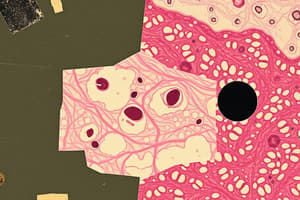Podcast
Questions and Answers
Which type of epithelium is best suited for rapid diffusion, such as in the lining of blood vessels and air sacs of the lungs?
Which type of epithelium is best suited for rapid diffusion, such as in the lining of blood vessels and air sacs of the lungs?
- Simple cuboidal epithelium
- Transitional epithelium
- Simple squamous epithelium (correct)
- Stratified squamous epithelium
Which of the following epithelial types is characterized by cells that change shape depending on the degree of stretch?
Which of the following epithelial types is characterized by cells that change shape depending on the degree of stretch?
- Simple columnar epithelium
- Transitional epithelium (correct)
- Stratified cuboidal epithelium
- Pseudostratified columnar epithelium
Considering its function in absorption and secretion, where would you most likely find simple columnar epithelium with microvilli?
Considering its function in absorption and secretion, where would you most likely find simple columnar epithelium with microvilli?
- Lining of the urinary bladder
- Lining of the trachea
- Lining of sweat glands
- Lining of the small intestine (correct)
In which of the following locations would you expect to find nonkeratinized stratified squamous epithelium?
In which of the following locations would you expect to find nonkeratinized stratified squamous epithelium?
Which type of epithelium, characterized by having all cells in contact with the basement membrane but not all reaching the surface, often contains cilia and is found lining the trachea?
Which type of epithelium, characterized by having all cells in contact with the basement membrane but not all reaching the surface, often contains cilia and is found lining the trachea?
Which of the following represents the correct matching of epithelium type to its location?
Which of the following represents the correct matching of epithelium type to its location?
Which type of epithelium lines the kidney tubules and is involved in secretion and absorption?
Which type of epithelium lines the kidney tubules and is involved in secretion and absorption?
What is the primary function of stratified squamous keratinized epithelium?
What is the primary function of stratified squamous keratinized epithelium?
Which type of epithelium is found lining the larger excretory ducts of salivary and sweat glands?
Which type of epithelium is found lining the larger excretory ducts of salivary and sweat glands?
Considering its location in the epididymis, what specialized feature would you expect to find on the apical surface of the pseudostratified columnar epithelium?
Considering its location in the epididymis, what specialized feature would you expect to find on the apical surface of the pseudostratified columnar epithelium?
Flashcards
Simple Squamous Epithelium
Simple Squamous Epithelium
Allows rapid diffusion and lines blood vessels and air sacs of lungs.
Simple Cuboidal Epithelium
Simple Cuboidal Epithelium
Single layer of cube-shaped cells, involved in secretion and absorption. Found in kidney tubules and thyroid.
Simple Columnar Epithelium
Simple Columnar Epithelium
Single layer of tall, column-shaped cells; specialized for absorption and secretion; lines digestive organs.
Pseudostratified Columnar Epithelium
Pseudostratified Columnar Epithelium
Signup and view all the flashcards
Transitional Epithelium
Transitional Epithelium
Signup and view all the flashcards
Stratified Squamous Epithelium
Stratified Squamous Epithelium
Signup and view all the flashcards
Stratified Cuboidal Epithelium
Stratified Cuboidal Epithelium
Signup and view all the flashcards
Stratified Columnar Epithelium
Stratified Columnar Epithelium
Signup and view all the flashcards
Stratified Squamous Nonkeratinized Epithelium
Stratified Squamous Nonkeratinized Epithelium
Signup and view all the flashcards
Stratified Squamous Keratinized Epithelium
Stratified Squamous Keratinized Epithelium
Signup and view all the flashcards
Study Notes
- Epithelial Tissue is the topic
Simple Squamous Epithelium
- Includes Mesothelium and Endothelium
- Allows rapid diffusion across the epithelium
- The tissue has cell boundaries, cytoplasm, and nuclei
- Can be found lining of vessels (endothelium) and serous lining of cavities: pericardium, pleura, peritoneum (mesothelium)
- Facilitates the movement of the viscera (mesothelium)
- Active transport by pinocytosis (mesothelium and endothelium)
- Secretes biologically active molecules (mesothelium)
- The glomerulus and Bowman's capsule in the kidney contain Simple Squamous Epithelium
Simple Cuboidal Epithelium
- Lines small excretory ducts in different organs
- Functions in Covering and Secretion
- Can be found in the thyroid, kidney tubules, or ovary
- This tissue is responsible for covering the ovary, thyroid, and secretion in those locations
Simple Columnar Epithelium
- Covers the digestive organs including the stomach, small and large intestine, and gallbladder
- Functions in Lubrication, absorption, protection, and secretion
- May have apical microvilli or cilia
- Microvilli are present in the intestines and gallbladder
- Ciliated Simple Columnar Epithelium is present in the fallopian tube and uterus
- Functions in protection, lubrication, absorption, and secretion
- Can be found in the lining of the intestine and gallbladder
Pseudostratified Columnar Epithelium
- Lines the upper respiratory passages such as the trachea and bronchi, and the lumina of the epididymis and vas deferens
- Frequently Ciliated
- Functions in protection, transport, and secretion
- Can be found in the lining of the trachea, bronchi, and nasal cavity
- Responsible for protection and secretion
- Responsible for cilia-mediated transport of particles trapped in mucus out of the air passages
Transitional Epithelium
- Found exclusively in the excretory passages of the urinary system
- Covers lumina of renal calyces, pelvis, ureters, and bladder
- Epithelium change shape in response to stretching, fluid accumulation, or contraction during voiding of urine
- Functions in Protection and Distensibility
- Can be found in bladder, ureters, and renal calyces
Stratified Squamous Epithelium
- Multiple cell layers exist
- Basal cells are cuboidal to columnar, cells toward the surface become squamous
- Has protective functions
- Two types: nonkeratinized or keratinized
Nonkeratinized (moist) Stratified Squamous Epithelium
- Exhibits live surface cells and covers moist cavities such as the mouth, pharynx, esophagus, vagina, and anal canal
- Can be found in the mouth, esophagus, larynx, vagina, and anal canal
- Functions in Protection and Secretion; Prevents water loss
Keratinized (dry) stratified squamous epithelium
- Lines external surfaces of the body
- Contains non-living surface keratinized cells known as skin
- Found in the epidermis
- Its main function is protection and prevention of water loss
Stratified Cuboidal Epithelium
- Limited distribution
- Lines larger excretory ducts of salivary and sweat glands
- Functions as protection and secretion
- Found in sweat glands and developing ovarian follicles
Stratified Columnar Epithelium
- Is of limited distribution
- Seen in the conjunctiva lining the eyelids
- Functions in protection and secretion
- Conjunctiva is where it can be located
Studying That Suits You
Use AI to generate personalized quizzes and flashcards to suit your learning preferences.




